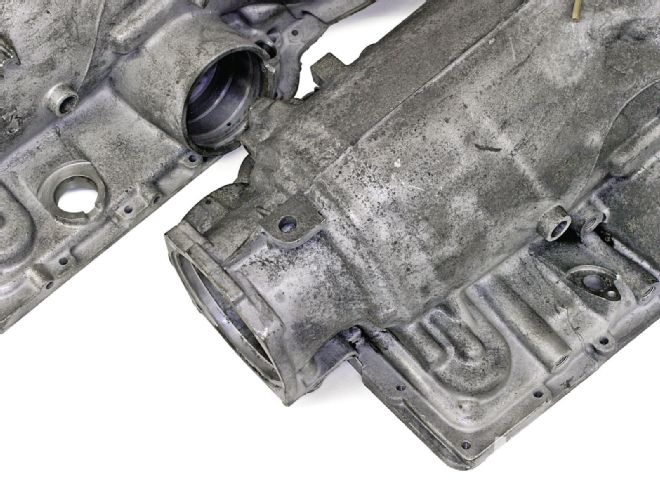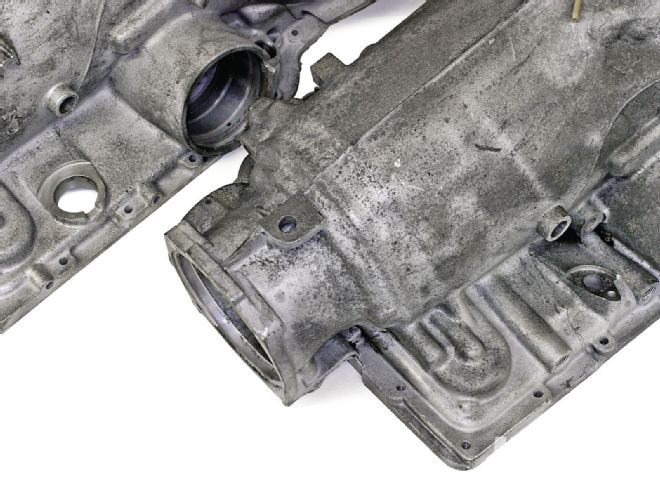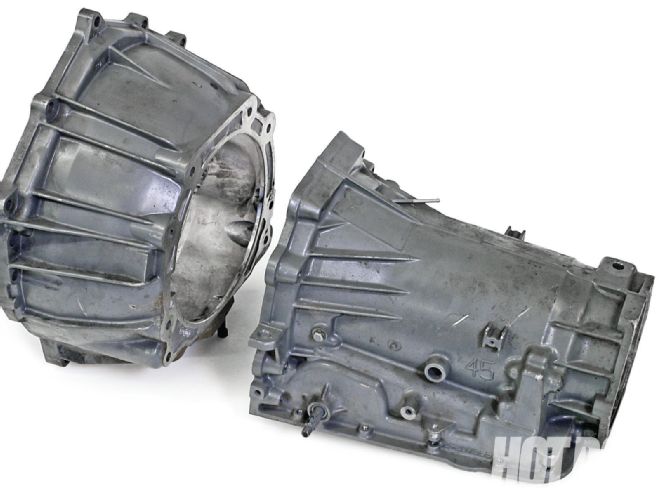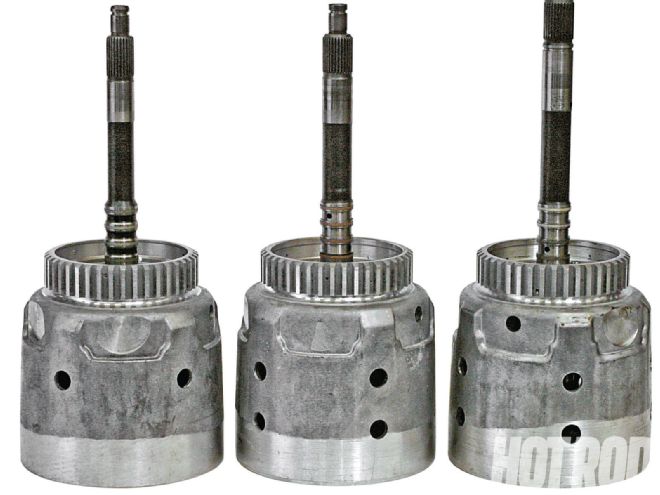
I am building a '49 Chevy panel truck with mostly junkyard parts. What do I have to do to use a 700-R4 trans with a carbureted 350 engine? The trans is new enough that it has a lot of wires going to it. I put an older one set up for a mechanical speedo in my '47 Ford and made believe it was a Turbo 350 (no electrical to it at all). It works well. This time, I will use an electronic speedo. You need to distinguish between the 700-R4 trans (which can be set up to run without a computer) and its later descendent, the 4L60E family (which is a fully electronic, totally computer-controlled transmission).
The '82–'93 700-R4 (later models may be designated "4L60," without the "E") has a square, four- or five-pin main electrical connector and a large governor cover--all located on the lefthand (driver) side of the case. There are usually provisions to hook up a conventional speedometer cable on the lefthand side of the extension housing, although on some models, a vehicle speed sensor (VSS) with an additional two-wire connector replaces the conventional speedometer drive and driven gears. A mechanical throttle valve and cable (TV cable) is located toward the rear of the case's righthand side. Most 700-R4 experts recommend avoiding problematic '82–'86 models. By 1987, most issues were fixed, and--particularly on units from high-performance cars like the IROC Z, Trans Am, or Corvette--the 700-R4 now makes a reasonably strong performance trans in stock form when in good condition.
 The 700-R4/4L60 uses a TV cable that attaches to the right rear of the case's passenger side (A). On the 4L60E, 4L65E, and 4L70E, the TV cable mounting provisions are eliminated, and a large, round computer connector is now located in the same location (B).
The 700-R4/4L60 uses a TV cable that attaches to the right rear of the case's passenger side (A). On the 4L60E, 4L65E, and 4L70E, the TV cable mounting provisions are eliminated, and a large, round computer connector is now located in the same location (B).
Introduced in trucks in 1993 and rear-wheel-drive passenger cars in 1994, the 4L60E (and its later, beefier descendents, the 4L65E and 4L70E) are fully electronic, computer-controlled transmissions. Although at first glance they superficially resemble the 700-R4, the modernized "E" versions feature a large, round, 11- to 14-pin electrical connector located toward the rear of the trans case's righthand side. There are no TV cable, mechanical speedometer drive, or governor provisions. The VSS connector now moves to the righthand side of the extension housing. Most '96-and-later versions have a separate, bolt-on bellhousing, as well as a six-bolt (instead of the previous four-bolt) extension housing.
To run a 700-R4 trans behind a carbureted engine without a computer, at the very least the TV cable must be hooked up to the carburetor and properly adjusted. Not just a simple kickdown cable like your TH350 analogue, the TV cable controls line pressure and shift points. Failure to get the adjustment right will eventually burn up the transmission due to insufficient line pressure. "Proper adjustment" means the cable itself requires proper preload adjustment, the cable "pull" must have the right tension, and the way the cable attaches to the carburetor's throttle-linkage must have the correct geometry. Over the years, various aftermarket companies have offered retrofit brackets and other solutions to ease the pain of putting a 700 behind an older carburetor.
 During 1996, GM transitioned to new 4L60E cases with separate bellhousings. If your trans has the separate bell, it's definitely an "E"--but be sure the bellhousing is correct for your engine family. If it has an integrated bellhousing, the trans can be either a 4L60E or a 700-R4. You'll need to check the other identifying characteristics.
During 1996, GM transitioned to new 4L60E cases with separate bellhousings. If your trans has the separate bell, it's definitely an "E"--but be sure the bellhousing is correct for your engine family. If it has an integrated bellhousing, the trans can be either a 4L60E or a 700-R4. You'll need to check the other identifying characteristics.
For instance, in place of a of wrecking-yard or generic-universal TV cable that may not have the right pull angle or tension for your application, TCI offers what it calls an EZ-Shift Cable. Applicable to 200-4R, 700-R4, and 4L60 (non-E) transmissions, the kits come with a cable and a mounting bracket that collectively achieve the desired straight pull, similar to a typical throttle-cable. The cable's easy adjuster has a push button instead of the traditional TV cable's adjustment tang. To set it up, depress the button, have a partner floor the throttle from inside the driver's compartment, and then release the button. Game, set, match.
Order the EZ-Shift Cable by part number to obtain the right cable and mounting bracket to mate with these popular performance carburetors:
Carburetor Part No. Edelbrock 370810 Holley 370811 Demon* 370812 *Original style, not the new ThermoQuad clones.Better yet, pair the EZ-Shift Cable with TCI's fail-safe, constant-pressure valvebody (see photo). The correct valvebody will vary by trans model and year:
Trans And Model Year Part No. '81–'90 200-4R 386020 '82–'87 700-R4 376021* '88–'92 700-R4 376020 *'87 models with auxiliary-style valvebody: use PN 376020.The 700-R4's four- or five-prong electrical connector is primarily responsible for TCC (torque converter clutch) lockup. Running "no electrical to it at all" (as you say was the case in your previous swap) means--you guessed it--the TCC never locks up. Although not a fatal durability error, this prevents the 700-R4 from achieving its ultimate efficiency and fuel-economy potential. On stock installations, the wires went to the computer to control TCC lock/unlock, but on a retrofitted 700-R4, lockup can be achieved by wiring up analog pressure and/or vacuum switches. There are various home-brewed ways to accomplish this, but due to detailed differences through the years, such schemes may not be applicable to every model. Today, it's easiest to just buy an aftermarket TCC wiring kit, especially as they're now widely available from a bunch of sources. TCI's rendition (PN 376600) universally works on all 700-R4/4L60 (non-E) transmissions by rewiring the solenoid inside the trans. Externally, all it needs is a 12-volt source and an engine-vacuum reference.
 Originally, 700-R4s used a weak 27-spline input shaft (left). Stay away from these wimps. Starting in 1984, V8/V6-90 versions got a larger, 30-spline input (center). Most separate-bellhousing 4L60Es use a 30-spline input with a revised tip (right). Torque-converter selection must match the input-shaft configuration.
Originally, 700-R4s used a weak 27-spline input shaft (left). Stay away from these wimps. Starting in 1984, V8/V6-90 versions got a larger, 30-spline input (center). Most separate-bellhousing 4L60Es use a 30-spline input with a revised tip (right). Torque-converter selection must match the input-shaft configuration.
However, if your trans is, in fact, a 4L60E, running it off a computer is mandatory. On "E" transmissions, the computer controls everything: TCC lockup, gear changes, shift quality and firmness, and line pressure. There are no external adjustments and no noncomputer workarounds. Never mind TCC lockup; without a computer, the trans won't shift at all. But you don't need an original factory engine management unit (ECU) to get the trans in gear (pun intended); user-friendly standalone transmission control units (TCUs) are available from several aftermarket sources. The TCI solution is its EZ-TCU transmission controller, which comes fully configured and ready to run right out of the box. However, the end user can reprogram as desired to alter transmission shift points, shift firmness, and shift speed--all without internally delving into the trans.
The EZ-TCU still needs to acquire a signal from a throttle-position sensor (TPS), which references the amount of throttle opening to the TCU. Think of it as sort of an electronic version of a mechanical TV cable. The good news is there's no longer a pesky TV cable to adjust. The bad news is some type of bracket is needed to mount up the switch to the carb's throttle-linkage. That used to call for custom fabrication, but now TCI offers a remote TPS mounting solution (PN 37401 for carbureted applications). It has a cable, so you can mount the switch on the firewall or other convenient location; there is no need to kludge up the carb's throttle-linkage itself.
As for interfacing any of these transmissions to an aftermarket electric speedometer, the process can vary depending on which trans and VSS you have and the particular aftermarket unit's characteristics. Consult your speedometer manufacturer for its recommended solution. If it doesn't offer the correct adapter interface, check out Dakota Digital, which offers several different universal-signal correction solutions (as well as its own full line of high-tech instrumentation).